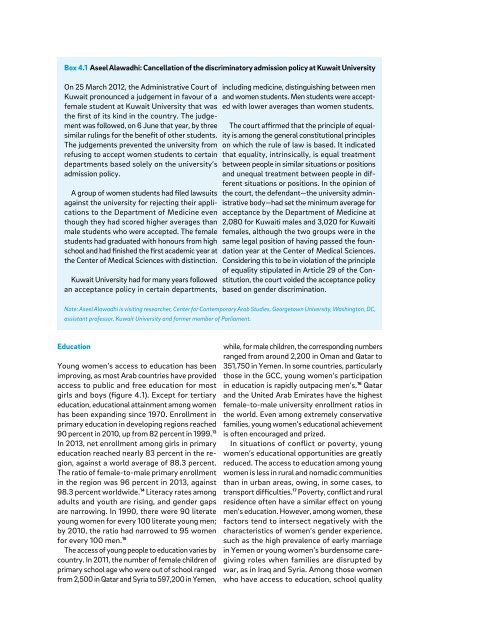Arab Human Development Report 2016
z6bSXU
z6bSXU
You also want an ePaper? Increase the reach of your titles
YUMPU automatically turns print PDFs into web optimized ePapers that Google loves.
Box 4.1 Aseel Alawadhi: Cancellation of the discriminatory admission policy at Kuwait University<br />
On 25 March 2012, the Administrative Court of<br />
Kuwait pronounced a judgement in favour of a<br />
female student at Kuwait University that was<br />
the first of its kind in the country. The judgement<br />
was followed, on 6 June that year, by three<br />
similar rulings for the benefit of other students.<br />
The judgements prevented the university from<br />
refusing to accept women students to certain<br />
departments based solely on the university’s<br />
admission policy.<br />
A group of women students had filed lawsuits<br />
against the university for rejecting their applications<br />
to the Department of Medicine even<br />
though they had scored higher averages than<br />
male students who were accepted. The female<br />
students had graduated with honours from high<br />
school and had finished the first academic year at<br />
the Center of Medical Sciences with distinction.<br />
Kuwait University had for many years followed<br />
an acceptance policy in certain departments,<br />
including medicine, distinguishing between men<br />
and women students. Men students were accepted<br />
with lower averages than women students.<br />
The court affirmed that the principle of equality<br />
is among the general constitutional principles<br />
on which the rule of law is based. It indicated<br />
that equality, intrinsically, is equal treatment<br />
between people in similar situations or positions<br />
and unequal treatment between people in different<br />
situations or positions. In the opinion of<br />
the court, the defendant—the university administrative<br />
body—had set the minimum average for<br />
acceptance by the Department of Medicine at<br />
2,080 for Kuwaiti males and 3,020 for Kuwaiti<br />
females, although the two groups were in the<br />
same legal position of having passed the foundation<br />
year at the Center of Medical Sciences.<br />
Considering this to be in violation of the principle<br />
of equality stipulated in Article 29 of the Constitution,<br />
the court voided the acceptance policy<br />
based on gender discrimination.<br />
Note: Aseel Alawadhi is visiting researcher, Center for Contemporary <strong>Arab</strong> Studies, Georgetown University, Washington, DC,<br />
assistant professor, Kuwait University and former member of Parliament.<br />
Education<br />
Young women’s access to education has been<br />
improving, as most <strong>Arab</strong> countries have provided<br />
access to public and free education for most<br />
girls and boys (figure 4.1). Except for tertiary<br />
education, educational attainment among women<br />
has been expanding since 1970. Enrollment in<br />
primary education in developing regions reached<br />
90 percent in 2010, up from 82 percent in 1999. 13<br />
In 2013, net enrollment among girls in primary<br />
education reached nearly 83 percent in the region,<br />
against a world average of 88.3 percent.<br />
The ratio of female-to-male primary enrollment<br />
in the region was 96 percent in 2013, against<br />
98.3 percent worldwide. 14 Literacy rates among<br />
adults and youth are rising, and gender gaps<br />
are narrowing. In 1990, there were 90 literate<br />
young women for every 100 literate young men;<br />
by 2010, the ratio had narrowed to 95 women<br />
for every 100 men. 15<br />
The access of young people to education varies by<br />
country. In 2011, the number of female children of<br />
primary school age who were out of school ranged<br />
from 2,500 in Qatar and Syria to 597,200 in Yemen,<br />
while, for male children, the corresponding numbers<br />
ranged from around 2,200 in Oman and Qatar to<br />
351,750 in Yemen. In some countries, particularly<br />
those in the GCC, young women’s participation<br />
in education is rapidly outpacing men’s. 16 Qatar<br />
and the United <strong>Arab</strong> Emirates have the highest<br />
female-to-male university enrollment ratios in<br />
the world. Even among extremely conservative<br />
families, young women’s educational achievement<br />
is often encouraged and prized.<br />
In situations of conflict or poverty, young<br />
women’s educational opportunities are greatly<br />
reduced. The access to education among young<br />
women is less in rural and nomadic communities<br />
than in urban areas, owing, in some cases, to<br />
transport difficulties. 17 Poverty, conflict and rural<br />
residence often have a similar effect on young<br />
men’s education. However, among women, these<br />
factors tend to intersect negatively with the<br />
characteristics of women’s gender experience,<br />
such as the high prevalence of early marriage<br />
in Yemen or young women’s burdensome caregiving<br />
roles when families are disrupted by<br />
war, as in Iraq and Syria. Among those women<br />
who have access to education, school quality


